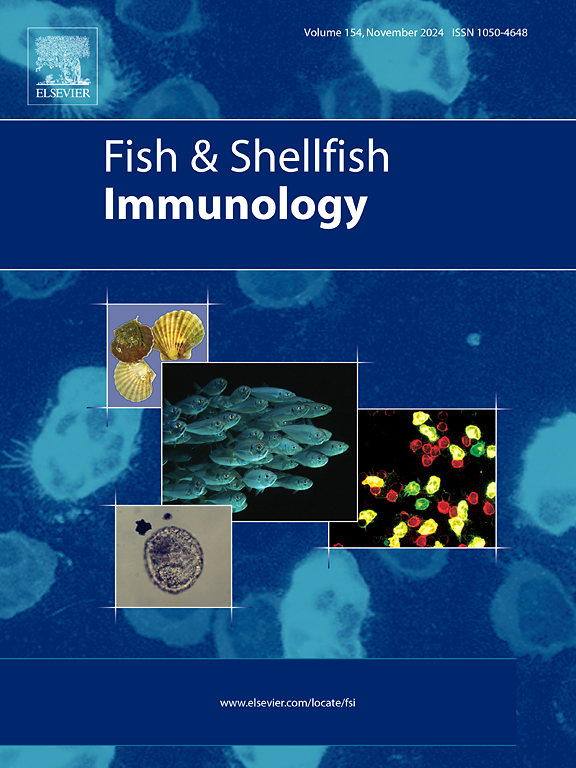Functional characterization of large yellow croaker (Larimichthys crocea) Peroxiredoxin IV (PrxIV) gene promoter
IF 4.1
2区 农林科学
Q1 FISHERIES
引用次数: 0
Abstract
Peroxiredoxin IV (PrxIV), which possesses an N-terminal signal peptide, is the only secretable protein in Prx family. PrxIV can protect cells against reactive oxygen species (ROS) and act as a DAMP to promote infection-independent immune response. However, the characterization and regulation of promoters of PrxIV genes are rarely reported. In this study, a 1511-bp 5′-flanking sequence of large yellow croaker (Larimichthys crocea) PrxIV (LcPrxIV) was cloned and characterized. DNA truncation combined with luciferase activity assay revealed that a fragment of −781/+20 contained in the plasmid LcPrxIV-P3 exhibited the highest promoter activity. It could initiate the luciferase expression up to 44.6-fold when compared to control plasmid pGL3-Basic. TFSEARCH analysis revealed many recognizing sequences of transcriptional factors exist within this 1511-bp sequence, including Foxo and CREB. Altogether, four putative binding sites located in three recognizing sequences of CREB were identified. Notably, co-transfection of LcPrxIV-P3 with LcCREB led to a significant 2.48-fold increase of the LcPrxIV-P3 promoter activity (P<0.01). Furthermore, the mutation at putative binding sites A, B, and all four sites of CREB in the LcPrxIV-P3 caused the significant decrease of activation on LcPrxIV-P3 promoter activity, suggesting these two sites may be the main binding sites of CREB in LcPrxIV promoter. In addition, the oxidative stress caused by hydrogen peroxide, rather than immune stimuli such as Poly (I: C), LPS, LTA, or PGN could lead to the elevation of LcPrxIV-P3 promoter activity. When the concentration of hydrogen peroxide reached 500 μM, the promoter activity of LcPrxIV-P3 could be up-regulated to 1.47-fold, which was extremely significantly different from the control (P<0.001). These results help to elucidate the regulatory mechanisms of LcPrxIV gene expression, and the role of LcPrxIV in protecting cells against oxidative stress or in oxidoreduction-dependent signal transduction.
大黄鱼 Peroxiredoxin IV (PrxIV) 基因启动子的功能特征。
具有 N 端信号肽的过氧化还原酶 IV(PrxIV)是 Prx 家族中唯一可分泌的蛋白质。PrxIV 可保护细胞免受活性氧(ROS)的侵害,并可作为 DAMP 促进独立于感染的免疫反应。然而,关于 PrxIV 基因启动子的特征和调控却鲜有报道。本研究克隆并鉴定了大黄鱼(Larimichthys crocea)PrxIV(LcPrxIV)的1511-bp 5'侧翼序列。DNA截断和荧光素酶活性测定显示,质粒LcPrxIV-P3中含有的-781/+20片段具有最高的启动子活性。与对照质粒 pGL3-Basic 相比,它能启动荧光素酶表达达 44.6 倍。TFSEARCH分析显示,在这1511-bp序列中存在许多转录因子的识别序列,包括Foxo和CREB。在 CREB 的三个识别序列中,共发现了四个推定结合位点。值得注意的是,LcPrxIV-P3 与 LcCREB 共转染后,LcPrxIV-P3 启动子活性显著增加了 2.48 倍(P<0.05)。
本文章由计算机程序翻译,如有差异,请以英文原文为准。
求助全文
约1分钟内获得全文
求助全文
来源期刊

Fish & shellfish immunology
农林科学-海洋与淡水生物学
CiteScore
7.50
自引率
19.10%
发文量
750
审稿时长
68 days
期刊介绍:
Fish and Shellfish Immunology rapidly publishes high-quality, peer-refereed contributions in the expanding fields of fish and shellfish immunology. It presents studies on the basic mechanisms of both the specific and non-specific defense systems, the cells, tissues, and humoral factors involved, their dependence on environmental and intrinsic factors, response to pathogens, response to vaccination, and applied studies on the development of specific vaccines for use in the aquaculture industry.
 求助内容:
求助内容: 应助结果提醒方式:
应助结果提醒方式:


